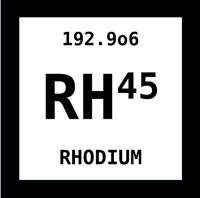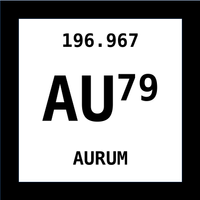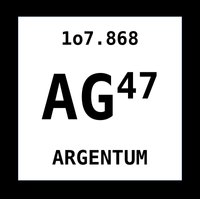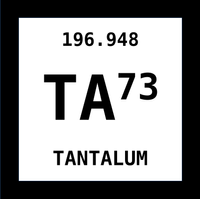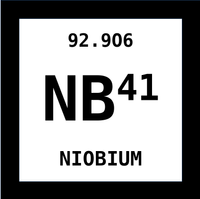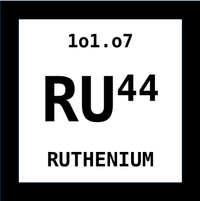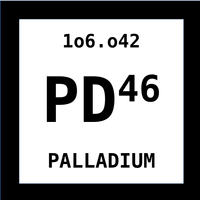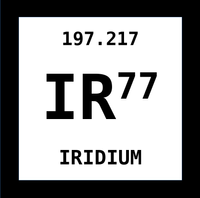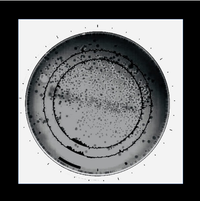Rhodium 45
1804 WOLLASTEN
Rhodium was identified in 1804 by Wollaston in a platinum ore from South America. The name is derived from the Greek ροδον (pink) on account of the pinkish-red colour of rhodium salts. A silvery white, shiny metal. It does not tarnish in air. Outstanding resistance to corrosion, endowed with high light-reflecting power makes it is one of the strongest metals mechanically. When brought to red-hot temperature in air, it converts slowly to the sesquioxide Rh2O3.
RHODIUM (RH)
Rhodium (Rh), chemical element, one of the platinum metals of Groups 8–10 (VIIIb), Periods 5 and 6, of the periodic table, predominantly used as an alloying agent to harden platinum. R hodium is a precious, silver-white metal, with a high reflectivity for light. It is not corroded or tarnished by the atmosphere at room temperature and is frequently electroplated onto metal objects and polished to give permanent, attractive surfaces for jewelry and other decorative articles. The metal is also used to produce reflecting surfaces for optical instruments.
PLATINUM ALLOYS
Rhodium added to platinum in small amounts yields alloys that are harder and lose weight at high temperatures even more slowly than pure platinum. Such alloys are used for laboratory furnace crucibles, spark-plug electrodes, and catalysts in very hot chemical environments (including automobile catalytic converters).
RHODIUM-PLATINUM ALLOYS
In the industrial manufacture of nitric acid, gauze catalysts of rhodium–platinum alloys are used because they can withstand the flame temperature as ammonia is burned to nitric oxide. A wire of the alloy 10 percent rhodium–90 percent platinum joined to a wire of pure platinum forms an excellent thermocouple for measuring high temperatures in an oxidizing atmosphere. The international temperature scale is defined over the region from 660° to 1,063° C (1,220° to 1,945° F) by the electromotive force of this thermocouple.
Rhodium is a rare element comprising up to 4.6 percent of native platinum alloys. It also occurs in native alloys of iridium and osmium: up to at least 11.25 percent in iridosmine and up to at least 4.5 percent in siserskite. Rhodium occurs in nature in association with the other platinum metals, and its separation and refinement form part of the overall metallurgical processing of the group. Rhodium is generally obtained commercially as a by-product of the extraction of nickel and copper from their ores.
NATURAL RHODIUM
Natural rhodium consists entirely of stable isotope rhodium-103. The element was first isolated (1803) from crude platinum by the English chemist and physicist William Hyde Wollaston, who named it from the Greek rhodon (“rose”) for the red colour of a number of its compounds. Rhodium is highly resistant to attack by acids; the massive metal is not dissolved by hot concentrated nitric or hydrochloric acids or even by aqua regia. The metal dissolves in fused potassium hydrogen sulfate to yield a complex, water-soluble sulfate, in hot concentrated sulfuric acid, and in concentrated hydrochloric acid containing sodium perchlorate at 125°–150° C (257°–302° F).
RHODIUM CHEMISTRY
Rhodium chemistry centres chiefly on the +1 and +3 oxidation states; a few compounds of the other positive oxidation states through +6 are recognized. Rhodium forms the dirhodium tetraacetate, Rh2(O2CCH3)4 and various derivatives containing two additional ligands—e.g., water, pyridine, or triphenylphosphine—in oxidation state +2. Complexes in oxidation state +1 chiefly contain carbon monoxide, olefins, and phosphines as ligands.
RHODIUM COMPOUNDS
All rhodium compounds are readily reduced or decomposed by heating to yield the powdered or sponge metal. Among these compounds rhodium trichloride, (in which rhodium is in the +3 state), is one of the most important. It provides a starting material for many of the other rhodium compounds in various oxidation states. In aqueous emulsions it can catalyze a number of useful organic reactions.
